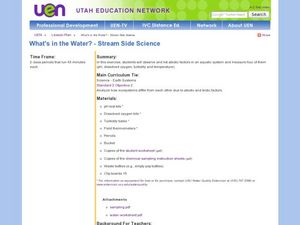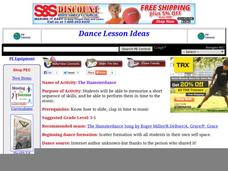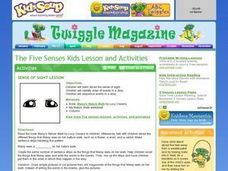DK Publishing
Sneaky Snake: Numbers
Find the numbers that the sneaky snakes are hiding! Using a number table, primaries determine which numbers are covered up by snakes. They write in the numbers next to the matching snake below the table, which reinforces both counting...
American Museum of Natural History
Horse Gaits Flipbooks Walk, Trot, and Gallop!
Scholars follow seven steps to create horse-themed flipbooks. Three printable options allow them to choose from walking, trotting, or galloping scene.
It's About Time
How Electrons Determine Chemical Behaviors
Lead the class on an investigation as they play detective and locate patterns in the electron arrangement of atoms. During the seventh lesson, they assign valence numbers to elements, organize the periodic table in the correct sequence,...
02 x 02 Worksheets
Inverse Variation
Discover an inverse variation pattern. A simple lesson plan design allows learners to explore a nonlinear pattern. Scholars analyze a distance, speed, and time relationship through tables and graphs. Eventually, they write an equation to...
Curated OER
Multiples
A great worksheet for scaffolding critical thinking about mathematical concepts. This resource provides students with a brief explanation of multiples followed by 29 practice problems which gradually increase in difficulty. Several...
Curated OER
Dot Plots
Number crunching statisticians explore displaying data with dot plots and define the difference between quantitative data and qualitative data. Dot plots are created based on a set of given data and analyzed.
Curated OER
Counting by 2s, part 2
Two, four, six, eight...can your scholars count by twos? They fill in missing numbers in 18 number sequences, all of which require skip counting by twos. Some begin on an even number and others odd, however all of these are whole...
Houghton Mifflin Harcourt
Unit 4 Math Vocabulary Cards (Grade K)
In need of a set of math vocabulary cards for beginning mathematicians? Use a resource that contains 15 vocabulary cards. The top half of each sheet has the word printed in bold text, while the bottom is a picture representing the...
Curated OER
Moby Dick Puppetry
Such an ambitious lesson! Third graders with special needs listen to an audio recording of the novel, Moby Dick. They stop often to discuss each of the main characters and analyze their actions in the story. They then make puppets of one...
Curated OER
Getting to Know You
After going over the five steps of the writing process, pupils fill out "Getting to Know You" worksheets. They trade papers with each other, and have the task of writing a descriptive paragraph about the person whose worksheet they...
Curated OER
Sweet Clara and the Freedom Quilt: The Real Story
Students learn how slaves communicated with each other. In this slavery and freedom instructional activity, students learn how slaves used quilts as maps, learn what different quilt patterns meant, draw a picture for their class freedom...
Curated OER
What's in the Water? - Stream Side Science
Here is a complete activity in which young biologists or ecologists test the pH, dissolved oxygen, turbidity and temperature of stream water. The class visits an actual stream and makes observations of the site. They use scientific...
Curated OER
The Hamsterdance
It's unbelievable that there really is a dance that goes with a song called "The Hamsterdance!" This is not a lesson plan per se, but rather steps to the dance. They include head bobs, slide steps, thigh slaps, and clapping. Short dances...
Curated OER
Investigation: Crazy Caterpillars
First graders explore biology patterns by creating a model insect. In this patterns lesson plan, 1st graders utilize snap cubes and pattern blocks to recreate their own version of a centipede or caterpillar. Students create their...
Curated OER
Manu's Song
Fourth graders observed the following pattern: snap, clap, snap, clap....Join my pattern when you know how it goes. After the all the students can follow the pattern ask them if they can use counters (2 colors) to show the pattern.
Ask...
Curated OER
Marcy's Dots
Students identify the pattern changes that could occur in a series using pictures with dots. They use the patterns on the worksheets to have a context to describe pattern in words. Students look to find the linear, quadratic, or...
Curated OER
3c and 5c Stamps
Students explore multiples of consecutive numbers. Given a real life situation, students devise and use problem solving strategies. Students describe what it means for a sequence to carry on to infinity. They locate patterns in...
Curated OER
Sorting Sizes
Students follow a pattern. In this sorting lesson, students are given various objects and they must sort them from smallest to largest.
Curated OER
Lesson Plan on Migration
Fourth graders diagram written and oral directions of a Native American, European Viking, Right Whale or Humpback Whale migration route, the student diagram all directions only in the sequence given, with arrows indicating direction of...
Curated OER
Elements of Art
Students explore three topics of elements of art in this seven lessons unit. An overview of light, space, figure, ground, pattern, balance and symmetry are presented in this unit.
Curated OER
Timelines
First graders examine what a timeline is and how it shows a sequence of events. They look at a timeline of the teacher's life before they design a timeline of their own based on major events in their lives. Finally, they right one event...
Curated OER
Sense of Sight Lesson
Students sequence what they saw in the book Maisy's Nature Walk. In this sequencing lesson plan, the teacher reads the book and the children listen and observe. Once the book is read, the students have to sequence what Maisy saw on her...
Curated OER
Betsy Bear Does a Trick
Help your youngsters develop an understanding of sequence and order of events in a story, with this fun simple tale about Betsy the Bear and her tricks. They will cut out images of Betsy and match them to the correct description and...
Curated OER
What Happened Next?
Fifth graders read one short story on their own. After reading, they are given a series of sentences and events from the short story and put them into the correct sequence. To end the lesson, they draw pictures from the story and...

























